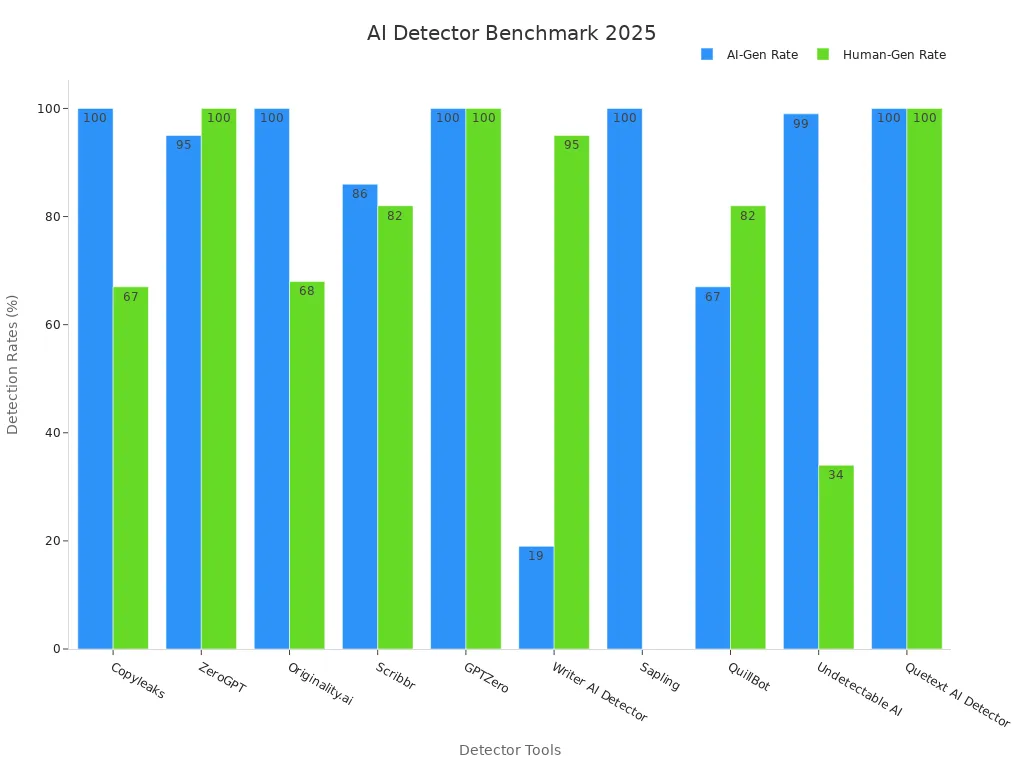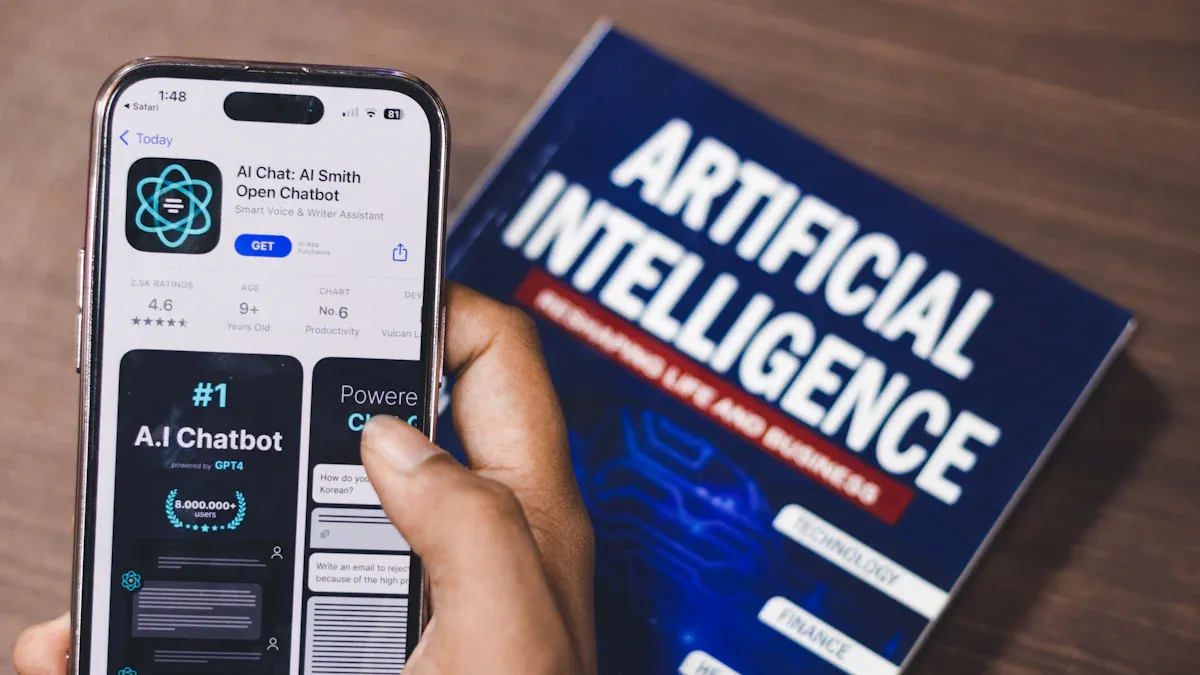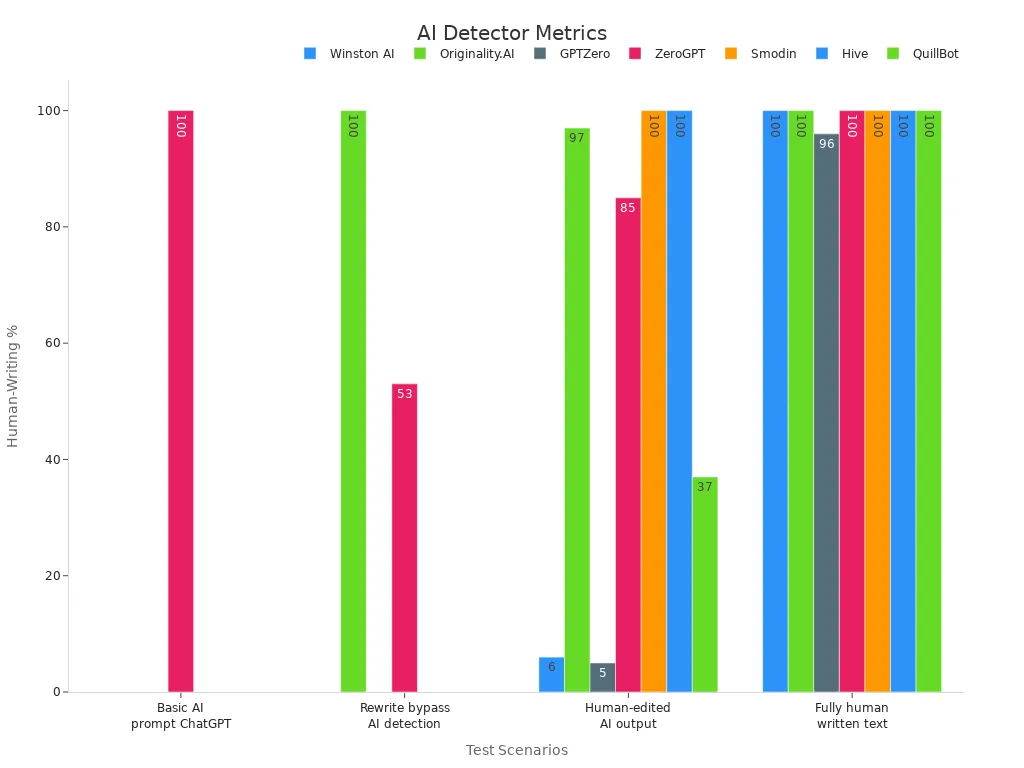
You’ve probably noticed more ai-generated content popping up everywhere in 2025. The demand for ai content detector tools keeps rising as people want the best ai content detector for accuracy and reliability. Just look at these numbers:
|
Detector |
Growth in AI-flagged abstracts (2021-2023) |
Accuracy Rate |
|---|---|---|
|
Originality.ai |
97.6% |
|
|
ZeroGPT |
+139% |
Educators, businesses, and publishers rely on ai content detection tools to get clear ai detection results.
Key Takeaways
-
Top AI content detectors vary in accuracy and features, so choose tools that fit your specific needs like education, business, or content creation.
-
Combine AI detection results with your own judgment to ensure content authenticity and avoid false positives or negatives.
-
Use multiple AI detectors and free trials to find reliable tools that support your languages and integrate well with your workflow.
Top 10 AI Content Detector Tools
Choosing the right ai content detector tools can feel overwhelming, especially with so many options in 2025. To help you get the most accurate ai detection results, here’s a breakdown of the top 10 ai content detector tools. These ai content detectors stand out for their accuracy, features, and real-world performance. You’ll see how each ai-powered content detector works, what makes it unique, and which use cases fit best.
Note: The following chart shows how these top 10 ai content detector tools perform on both AI-generated and human-generated text. This benchmark comes from a hands-on test by AIMultiple, which looked at detection rates, web traffic, and user reviews.

|
Tool |
AI-Generated Text Detection Rate |
Human-Generated Text Detection Rate |
|---|---|---|
|
Copyleaks |
100% |
67% |
|
ZeroGPT |
95% |
100% |
|
Originality.ai |
100% |
68% |
|
Scribbr |
86% |
82% |
|
GPTZero |
100% |
100% |
|
Writer AI Detector |
19% |
95% |
|
Sapling |
100% |
0% |
|
QuillBot |
67% |
82% |
|
Undetectable AI |
99% |
34% |
|
Quetext AI Detector |
100% |
100% |
Let’s dive into each ai text detector and see what sets them apart.
Originality.ai
Originality.ai is a favorite among educators and publishers who want reliable ai detection results. You get high accuracy, with studies showing rates between 94% and 99% for detecting ai-generated content. In a university case study, Originality.ai correctly flagged 98% of ai-generated essays and kept false positives low at just 2%. This ai-powered content detector also shines in fact-checking, paraphrase detection, and plagiarism detection. If you need to check content for authenticity every day, this tool delivers consistent results and helps you keep your content trustworthy.
-
Best for: Academic writing, publishing, agencies
-
Key features: High accuracy, low false positives, fact-checking, plagiarism detection
-
Languages: English, Russian, Spanish, Chinese, and more
Copyleaks
Copyleaks stands out for its 100% detection rate on ai-generated text in recent benchmarks. You can use it for both ai detection and plagiarism detection, making it a solid choice for schools and businesses. Copyleaks supports over 30 languages, so you can check content in English, Spanish, Chinese, and more. While it sometimes flags human-written text as ai, it remains a top pick for those who need broad language support and strong ai detection results.
-
Best for: Multilingual content, education, business
-
Key features: Multi-language support, plagiarism detection, detailed reports
-
Languages: 30+ languages
Sapling AI
Sapling AI is known for its sharp eye when it comes to ai-generated and paraphrased content. In controlled tests, Sapling AI detected 100% of ai-generated and paraphrased texts. However, it sometimes mislabels human-written content, so you’ll want to double-check results. Sapling AI works well if you need to catch even the most cleverly disguised ai writing, but keep in mind its tendency for false positives.
-
Best for: Editors, content reviewers, businesses
-
Key features: Paraphrase detection, fast scanning, browser extension
-
Languages: English
ZeroGPT
ZeroGPT is a popular free ai text detector that balances strong detection rates with easy access. It scored a 95% detection rate for ai-generated text and 100% for human-written text in recent benchmarks. However, some independent tests found that ZeroGPT can flag human essays as ai and sometimes misses ai-generated content. If you want a free tool for quick checks, ZeroGPT is a solid choice, but always review the ai detection results carefully.
-
Best for: Students, bloggers, quick checks
-
Key features: Free access, all-language support, simple interface
-
Languages: All languages
Winston AI
Winston AI claims a 99.98% accuracy rate for detecting ai-generated content. You’ll find its dashboard easy to use, and it gives you a color-coded map showing which sentences are likely ai-generated. Winston AI supports several languages, including English, French, Spanish, Dutch, German, and Chinese. Some users report false positives with well-edited human text, but the tool’s detailed reporting and weekly algorithm updates make it a strong contender among ai content detector tools.
-
Best for: Publishers, agencies, multi-language projects
-
Key features: Color-coded prediction map, PDF reports, multi-language support
-
Languages: English, French, Spanish, Dutch, German, Chinese
Turnitin
Turnitin is a classic name in plagiarism detection, now with ai writing detectors built in. Academic studies show Turnitin’s ai detection tool is about 79% accurate, with a 21% error rate. It rarely flags human-written work as ai, but it can miss ai-generated text that’s been edited. Turnitin integrates with learning management systems, making it easy for teachers to check student work for originality and ai use.
-
Best for: Schools, universities, academic integrity
-
Key features: LMS integration, detailed originality reports, plagiarism detection
-
Languages: English, with growing support for other languages
GPTZero
GPTZero is one of the most talked-about ai detection tools, especially for teachers and journalists. It scored 100% on both ai-generated and human-generated text in some benchmarks, but other studies show an 80% overall accuracy. GPTZero is great at confirming if something is ai-generated, but it sometimes misses subtle ai use. You get a low false-positive rate, so it’s a safe bet for confirming ai writing.
-
Best for: Educators, journalists, content reviewers
-
Key features: Sentence-level analysis, batch uploads, detailed scoring
-
Languages: English
AI Text Classifier
AI Text Classifier (Checkfor.ai) uses advanced algorithms to spot ai-generated content with 99% accuracy. It outperforms many commercial ai content detectors and keeps false positives low. You can trust this ai-powered content detector across different writing styles and even with nonnative English. If you need a reliable tool for diverse content, this one is worth a look.
-
Best for: Agencies, businesses, diverse content types
-
Key features: Robust detection, low false positives, supports multiple domains
-
Languages: English, strong performance with nonnative English
QuillBot AI Detector
QuillBot AI Detector is a handy tool for catching paraphrased ai-generated content. In a recent study, it identified 90% of paraphrased ai-generated text, making it a strong choice for editors and teachers. QuillBot is easy to use and works well for quick checks, but it may not catch every type of ai writing. If you often deal with rewritten or paraphrased content, this ai text detector can help you spot the difference.
-
Best for: Editors, teachers, paraphrased content
-
Key features: Paraphrase detection, user-friendly interface, quick results
-
Languages: English
Surfer AI Content Detector
Surfer AI Content Detector is a free tool that helps you spot ai-generated text by analyzing writing patterns. Editors, teachers, and content creators use it to keep content authentic. Surfer’s AI Humanizer feature can even make ai-generated content sound more natural, boosting engagement. While there’s no independent accuracy data yet, users report higher engagement after using the tool.
-
Best for: Content creators, publishers, authenticity checks
-
Key features: Free tool, AI Humanizer, engagement tracking
-
Languages: English
If you want the best ai detection results, try a few of these top 10 ai content detector tools and see which fits your workflow. Each ai text detector has its strengths, so matching the tool to your needs will help you get the most accurate results.
How AI Content Detectors Work

Detection Algorithms
Ever wondered how ai content detectors actually spot ai-generated text? These tools use a mix of smart algorithms and machine learning to catch synthetic writing. Here’s what happens behind the scenes:
-
The detector breaks your text into small pieces, called tokens, so it can look for patterns.
-
It checks for things like repeated phrases, predictable sentence structures, and words that show up too often—these are common in ai-generated content.
-
Machine learning models, trained on tons of examples, compare your writing to both human and synthetic samples.
-
The detector looks at how sentences flow, how varied the vocabulary is, and even how the text “feels” compared to known ai-generated text.
-
Some tools use probability scores, showing you how likely it is that your content is synthetic or human.
-
Advanced detectors even compare your text to huge databases of known ai-generated content to double-check their findings.
You’ll notice that ai content detectors don’t just look for one thing—they combine lots of clues to detect ai-written content and flag synthetic text.
Accuracy Factors
Getting accurate ai detection results isn’t always easy. Several things can affect how well these tools detect synthetic or ai-generated content:
-
The quality and variety of training data matter a lot. If the detector only learns from a narrow set of examples, it might miss new types of ai-generated text or flag human writing by mistake.
-
Some detectors struggle with short texts or technical writing, which can lead to more false positives or negatives.
-
The complexity of the model makes a difference. More advanced models spot subtle patterns but need more computing power.
-
Bias in training data can cause detectors to mislabel non-English or creative writing as synthetic.
-
Regular updates and human review help improve ai detection results, especially as new types of ai-generated content appear.
Tip: Studies show that people trust ai detection results more when tools clearly explain their accuracy and possible errors. If you’re using ai content detectors for important work, always check the tool’s transparency and combine ai detection results with your own judgment.
|
Aspect Evaluated |
Description |
|---|---|
|
Training Data Quality |
Diverse, high-quality data improves accuracy and reduces bias. |
|
Model Complexity |
Complex models catch more patterns but need more resources. |
|
Human Oversight |
Combining ai detection results with expert review lowers risk of mistakes. |
|
Transparency |
Clear communication about accuracy and errors builds user trust in ai content detectors. |
Best AI Content Detector Comparison

Accuracy and Reliability
When you look for the best ai content detector, you want tools that give you trustworthy ai detection results every time. Not all ai detection tools perform the same. Some catch ai-generated text easily, while others struggle with human-edited or paraphrased content. Take a look at this table showing how different tools handle various scenarios:
|
Scenario |
Winston AI |
Originality.AI |
GPTZero |
ZeroGPT |
Smodin |
Hive |
QuillBot |
|---|---|---|---|---|---|---|---|
|
Basic AI prompt (ChatGPT) |
0% |
0% |
0% |
100% |
0% |
0.01% |
0% |
|
Rewrite to bypass AI detection (Claude) |
0% |
100% |
0% |
53% |
0% |
0.01% |
0% |
|
Human-edited AI output (ChatGPT) |
6% |
97% |
5% |
85% |
100% |
100% |
37% |
|
Fully human-written text |
100% |
100% |
96% |
100% |
100% |
100% |
100% |
You can see that GPTZero and QuillBot keep a high detection rate, even when you edit ai-generated text. Winston AI and Originality.AI also show strong ai detection results, but sometimes miss heavily edited content. ZeroGPT and Hive sometimes misclassify ai-generated writing as human, so you may want to double-check their results.

Tip: If you need reliable ai detection accuracy, try using more than one tool for important checks.
Features and Integrations
You want ai detection tools that fit your workflow. Some tools, like Originality.AI, offer advanced plagiarism detection and support for multiple languages. GPTZero gives you sentence-level analysis and batch uploads, which help when you review lots of content. QuillBot stands out with a generous free plan and detailed reports. Winston AI offers color-coded prediction maps, making it easy to spot ai-generated sentences. Some tools, like Smodin, add grammar checking, but their interfaces may feel outdated. Always check if your chosen tool integrates with your favorite platforms, like Google Docs or learning management systems.
Pricing Overview
Pricing for ai content detector tools can vary a lot. You’ll find free plans with limited features, like QuillBot and ZeroGPT, which work well for quick ai detection results. Premium plans can cost anywhere from $20 to over $5,000 per month, depending on the features and usage limits. Subscription models often give you a discount if you pay yearly. Some tools use pay-as-you-go pricing, so you only pay for what you use. If you need advanced features like plagiarism detection or large-scale scanning, expect to pay more. The best ai content detector for you balances cost, features, and the accuracy you need.
Choosing AI Content Detector Tools
Key Selection Criteria
Picking the right ai content detector can feel tricky, but you can make it easier by focusing on a few key things. First, check the accuracy rate. You want a tool that catches most ai-generated content without flagging too much human writing. Next, look at the languages the tool supports. If you work with more than just English, this matters a lot. Think about how fast the tool works and if it fits into your daily routine. Some tools offer browser extensions or work inside Google Docs, which saves you time.
Here’s a quick checklist to help you decide:
-
Accuracy and reliability
-
Supported languages
-
Speed and ease of use
-
Integration with your favorite platforms
-
Price and free trial options
Tip: Try a free version first. You can see if the ai-powered content detector matches your needs before you pay.
Matching Tools to Needs
Not every ai content detector works for every job. If you teach or work in education, you might want a tool like Turnitin or GPTZero. These focus on academic honesty and work well with student essays. For business or publishing, Originality.ai or Copyleaks give you strong detection and extra features like plagiarism checks. Bloggers and content creators often like ZeroGPT or Surfer AI Content Detector for quick, free scans.
|
User Type |
Best Tools |
Why Choose Them? |
|---|---|---|
|
Educators |
Turnitin, GPTZero |
Academic focus, easy reports |
|
Businesses |
Originality.ai, Copyleaks |
High accuracy, extra features |
|
Creators |
ZeroGPT, Surfer AI Content Detector |
Fast, free, simple to use |
You can always mix and match tools to get the best results for your workflow.
Maximizing Results with AI Content Detectors
Best Practices
You want to get the most accurate ai detection results, right? Start by using ai tools as helpers, not as replacements for your own judgment. Keep your authorial voice strong and always double-check anything that looks suspicious. Map out your workflow and pick low-risk tasks for ai, like research summaries or editing drafts. When you use ai, craft clear prompts and break big jobs into smaller steps. This helps the tool give you better, more relevant ai detection results.
-
Always verify facts, citations, and technical details by checking trusted sources.
-
Watch for bias in synthetic content and ask for peer feedback if something feels off.
-
Review the terms of service for each ai tool to protect your rights.
-
If you handle sensitive data, choose enterprise versions with strong privacy controls.
-
Keep a log of when and how you use ai, including your own review steps.
-
Be transparent about your use of ai when you share your work.
Tip: Treat ai like a junior assistant. Experiment with different prompts and build your skills before you rely on it for important projects.
Common Limitations
Even the best ai content detectors have limits. Sometimes, they flag real writing as synthetic or miss deepfake and fake content. You might see false positives or negatives, which can cause problems like unfair academic penalties. Accuracy rates change between tools and models, ranging from about 93.8% to 99.98%. Some detectors struggle with non-native English or marginalized groups, leading to bias.
Detection of synthetic media, like deepfake images, remains tough. Studies by experts such as Dr. Anneke Schmidt and groups like ENAI show that misclassification happens. Relying only on ai detection results can be risky. You should always combine ai tools with your own judgment and boost your ai literacy. Educators now teach students how to spot fake and synthetic content, rethink assessments, and use ai responsibly.
Impact on SEO and Authenticity
SEO Considerations
You might wonder how ai-generated text and ai detection results affect your website’s search rankings. Search engines like Google now use advanced algorithms to spot ai-generated content that lacks content originality or value. If your site relies too much on ai-generated text without adding something new, you could see your rankings drop or even get removed from search results. Google’s focus on E-E-A-T (Experience, Expertise, Authoritativeness, Trustworthiness) means you need to show real expertise, especially for sensitive topics.
-
Google’s Search Quality Guidelines reward original content and penalize fake or low-quality ai-generated content.
-
Search engines want to see fresh, high-quality writing that engages users. If your ai-generated text feels generic or fake, your site might lose visibility.
-
User experience matters. If visitors bounce quickly, search engines may lower your rankings.
-
A 2024 BrightEdge study found that more ai-generated text appears in featured snippets, but only when it meets quality standards.
-
Marketers using ai tripled their output while keeping quality high, showing that ai can help if you focus on content verification and human editing.
You should also watch out for fake content and deepfake material. Search engines have started penalizing sites with fake or misleading information, so always review your ai detection results before publishing.
Ensuring Authentic Content
If you want your site to stand out, focus on content verification and authenticity. Authentic content builds trust and helps you rank higher. You can use ai detection results to check for fake or deepfake text, but don’t stop there. Combine these tools with your own review to make sure your content feels real and helpful.
-
Track organic traffic and keyword rankings to see if your content attracts the right audience.
-
Watch user engagement metrics like bounce rate and time on page. These numbers show if your ai-generated text connects with readers.
-
Use analytics tools to measure conversions and see the real impact of your content.
-
Address real problems and answer questions your audience cares about. This keeps your content relevant and original.
-
Organize your content by buyer journey stages and themes to improve search visibility.
Remember, ai detection results help you spot fake or ai-generated text, but your own expertise ensures content originality. Always update your site with new research, expert interviews, and case studies. This approach helps you avoid fake content and keeps your site safe from deepfake risks.
Tip: Most high-performing sites use both ai detection results and human editing. This combo helps you catch fake or low-quality ai-generated text before it hurts your rankings.
You’ve seen how the top 10 ai tools deliver strong ai detection results for different needs. If you’re an educator, business, or publisher, match your workflow to the right ai tool for the best ai detection results. Stay alert—ai detection results keep changing as ai evolves. Try these tools, compare ai detection results, and watch how your ai detection results improve. Use ai detection results to keep your content real. Rely on ai detection results for peace of mind. Share ai detection results with your team. Track ai detection results over time. Trust ai detection results to spot issues early. Let ai detection results guide your next steps. Your ai detection results will help you stay ahead.
FAQ
How accurate are AI content detectors?
You can expect most top tools to reach 95% accuracy or higher. Always double-check results, especially with creative or heavily edited text.
Tip: Try more than one detector for important checks!
Can AI detectors spot paraphrased or rewritten AI content?
Some tools, like Sapling AI and QuillBot, catch paraphrased AI writing. You should still review the results yourself for the best accuracy.
Do AI content detectors work with all languages?
Many detectors focus on English. Some, like Copyleaks and Winston AI, support multiple languages. Always check the tool’s language list before you scan your content.








